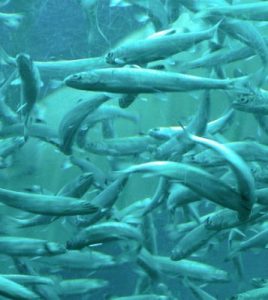Canada’s OTN and NOAA are building a global telemetry network to better understand aquatic animal movement
Anadromous fish, such as salmon, sturgeon and striped bass, travel between freshwater and marine habitats at various points in their life, making them difficult species to track and study.
But as our knowledge of these fish grows, the scientific community is learning that developing a truly comprehensive understanding will require research on a global scale — across divisions both hydrological and political.
A project from Canada’s Ocean Tracking Network and the National Oceanographic and Atmospheric Administration is taking advantage of improved tracking technology and significant grant funding to establish an international network of telemetry users around the world.
A paper detailing major developments in aquatic animal tracking is published in the journal Science.
By studying aquatic animals from a global perspective, the project hopes to uncover the intricacies of aquatic species’ habitat use and migration patterns, including their response to physical and biological environmental features, animal interactions and human activity.
“Animals really do move across the entire ocean, and don’t recognize if it’s the Atlantic or Pacific or anything like that,” said Sara Iverson, scientific director at OTN and biology professor at Dalhousie University in Nova Scotia.
Because of that movement, Iverson says, issues that seem regional can actually have a global impact.
The global tracking project grew out of several smaller studies, including one that predates OTN, in which U.S. and Canadian researchers tagged hundreds of threatened Atlantic salmon smolts in Halifax, Canada.
“Previously, when these salmon exited the rivers, no one knew where they went,” Iverson said. “In a very short time, nearly a third of them were detected crossing the acoustic array out of Halifax and into Newfoundland — and then all the way into Greenland.”

One NOAA telemetry project tagged hundreds of salmon smolts and tracked them from a river in Halifax all the way to the coastal waters of Greenland. (Credit: James Brooks/CC BY 2.0)
That study opened the researchers’ eyes to a need for more comprehensive tracking across political boundaries, and helped inspire the foundation of OTN.
“All of the ocean observatories that are in existence look at the chemical and physical properties that are in the ocean and atmosphere, but they really neglect the biological components,” Iverson said. “This is about trying to understand the whole ocean.”
OTN and NOAA’s Northeast Fisheries Science Center are working together to create a “very long-term sustainable platform” to track and study keystone species such as salmon, sharks, sturgeon and eels. While eels may not seem like the most obvious keystone species, Iverson noted that these long-distance migrators are among the top-three most important fisheries on the North American east coast, and certain species can fetch around $3,000 per pound.
The project doesn’t aim to establish a global telemetry network limited to research alone; OTN is already working to create sustainable fisheries in various parts of the world, and has even implemented acoustic tagging in shark warning systems in Australia and South Africa.
Improvements to tracking technology, particularly advances in miniaturization and battery life, have enabled this sort of project to exist, Iverson says. She also pointed to a Canadian innovation: the mobile transceiver, which can be affixed to larger animals and allows researchers to monitor interactions between the equipped creature and other tagged animals.
“It’s this whole notion of animals as oceanographers,” Iverson said. “These tagged animals go about undertaking their daily routine, they encounter whatever goes on in their environment, and they sample the ocean the same way an oceanographic vessel would.”
But animal tagging is quite a bit cheaper — not to mention safer — than conducting research from a vessel. Of course, unmanned vehicles such as wave-powered robotic gliders can do a pretty good job as well, and OTN has even started an annual “gliderpalooza” to collect massive amounts of real time data around the eastern seaboard.
Despite its name, OTN isn’t limited to the saltier waters of the world. Iverson noted that the Great Lakes Acoustic Observation System is also part of their network.
“It’s really a unified global network approach to aquatic telemetry that is going to be essential to the needs of ocean resource management,” Iverson said. “And the community working together is a really exciting thing.”
“It’s prompting a real paradigm shift in how we’re going to manage and protect the ocean resources and our fisheries,” she said.



0 comments